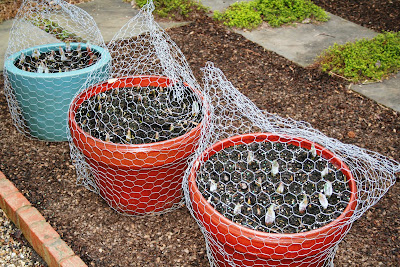Clerondedrum thomsoniae took a break for a couple of months, dropped most of her leaves, and looked quite sad. Now that the springtime sunshine has arrived, she's right back to growing a couple of feet every day and showing off those incredible blooms! Sometimes this is like the plant from
Little Shop of Horrors, since it grows up and over the ceiling, swallowing anything (and anyone) in its path.
Garden stakes have gotten their new coat of paint, so all looks fresh and spring-like! This is a very practical means of marking the vegetable garden that I took from Hidcote a couple of years ago. The stakes are readily available at the home center, and last a couple of years before starting to rot away. We write directly on them with paint pens.
Spring lettuces and spinach have been seeded in the hayracks, and move in and out of the glasshouse as weather allows.
Tulips are showing their tips in pots that will make their way to the front entrance of the house. The wire cages have worked beautifully against the evil squirrels. We realistically use tulips as an expensive annual flower in Atlanta, since the winters just don't get cold enough for them to perennialize.
It's definitely orchid season in the glasshouse! They hang out looking like the dour sisters all year, and then put on all their party bling in January and February. Now that they are in bloom, they'll go for a couple of months in this glorious state.
I'm usually bad about getting photos of things in their "finished" states. Here's a shot of that same orchid (with another, as well) in its home for the next several weeks. Despite their reputation for being persnickety, they are really very low maintenance. And what other flower has a bloom like that?
Sunny and 72 degrees in Atlanta today! Now THAT is a beautiful thing!
(Please enjoy the photos, and double click on them to enlarge if you'd like. Please don't claim them as your own in a post out there in the internet world, though......Thank you!)





















